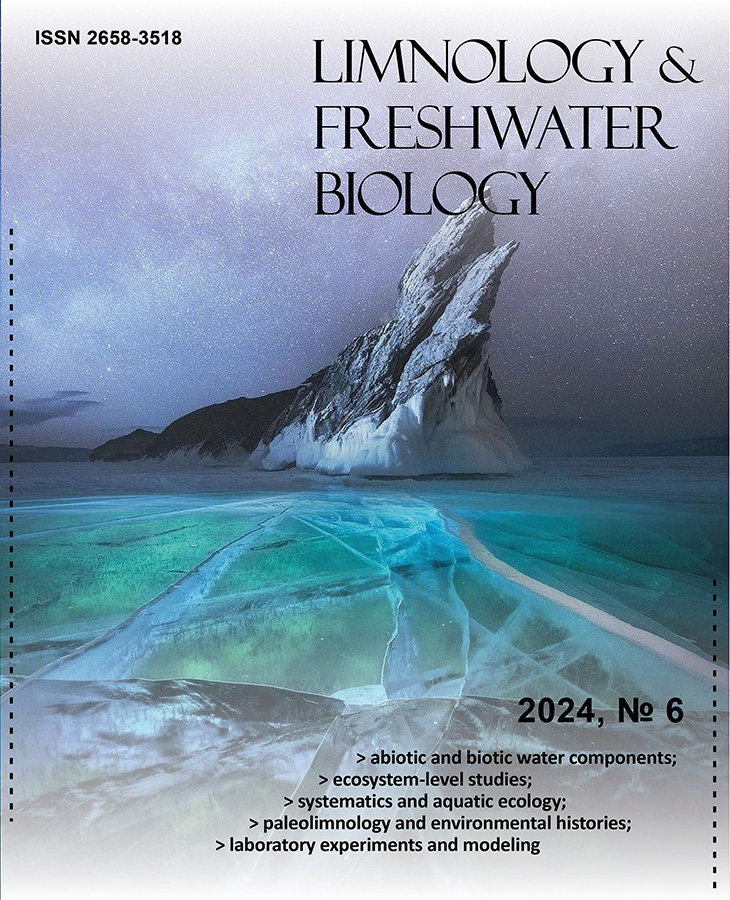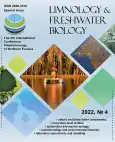Theoretical aspects in the study of sources and origin of modern and buried organic matter in biogenic deposits from salt lakes of the arid zone (Western Siberia, Russia)
- Authors: Leonova G.A.1, Krivonogov S.K.1, Maltsev A.E.1
-
Affiliations:
- Sobolev Institute of Geology and Mineralogy, Siberian Branch of the Russian Academy of Science
- Issue: No 4 (2022)
- Pages: 1467-1469
- Section: Articles
- URL: https://journal-vniispk.ru/2658-3518/article/view/289407
- DOI: https://doi.org/10.31951/2658-3518-2022-A-4-1467
- ID: 289407
Cite item
Full Text
Abstract
We present the approach and methods of research of biogenic sedimentation in lakes of arid zone of Eurasia, data from Western Siberia.
Keywords
Full Text
1. Biogenic deposits of lakes from different climatic zones of Western Siberia
Terminal lakes play an important role in deposition of organic matter (OM) in continental environment. The sediment origin and sedimentation intensity are depended many factors, including the climatic characteristics of the region. Content of OM in lakes located in high latitude subarctic climatic zone and high altitude mountains as usual is not high, while they can accumulate diatomite – inorganic biogenic sediment, presented in lakes of Kola Peninsula, Karelia, in Lakes Baikal and Sevan. Calcareous lake deposits may also be biogenic. Limestone sediments are formed from calcite and aragonite ostracod shells in the brackish-water Issyk-Kul Lake (Rasskazov et al., 2021). Boigenic calcite (CaCO3) also forms in some submerged macrophytes (Potamogeton) and Chara algae.
The most intensive accumulation of OM occurs in lakes of the boreal humid climatic zone.
Living organisms in these lakes have a high assimilation potential to produce biomass during photosynthesis. However, in order for a group of producer organisms to participate meaningfully in the formation of nutrient sediments must be: i) conditions for normal development in the lake (the value of primary production); ii) remain in lake sediments (Korde, 1960).
Bio-chemic deposits were accumulated in saline and hypergaline lakes at the arid climate zone with high rate of evaporation and salt precipitation process. Salinity of high-mineralized lake controls abundance and species diversity of halophile organisms, indirectly influences the primary production. According to our data (Leonova et al., 2006), the total salt content in the studied salt lakes of the arid zone of Western Siberia widely varied: Lake Kulundinskoye - 94, Lake Bolshoye Yarovoye -172, and Lake Maloye Yarovoye - 262 g/l. The sources of OM in modern biocenoses in these lakes are dominant planktonic halophilic species of cyanobacteria (Chlorogloea sarcinoides (Elenk.) Troizk.; Lingbia kassinskajae Elenk.; L. lutea (Ag.) Jom.), green algae (Dunaliella salina Kütz.), and filamentous green algae (Cladophora fracta (Vahl.) Kütz.), which in mass reproduction cause water-weeding. The zooplankton in the hypergaline lakes of the Kulunda steppe is represented by the brine shrimp (Artemia salina L.).
The primary production of OM is a result of reproduction of autotrophic photosynthetic phytoplankton, periphyton and macrophyton. The contribution of each group to the primary production depends on the degree of their development in lake biocenosis. Lake ecosystems are classified by the predominant OM from macrophytic and phytoplanktonic (Pokrovskaya et al., 1983).
The gross primary production of phytoplankton in lakes of the Kulunda steppe was determined by the light-and-dark-bottle method in oxygen modification (Vinberg, 1960). The method attracts by the simplicity of the experimental procedure. In the background bottles, the initial concentration of oxygen is measured. Then after daily exposure, oxygen concentrations in «light» bottles (oxygen formed during phytoplankton photosynthesis) and in «dark» bottles (oxygen used for phytoplankton respiration) are measured. The intensity of production and destruction processes in the water is determined by the difference of oxygen concentrations in «light» and «dark» bottles. The maximum value of phytoplankton photosynthesis (the value of primary production of organic carbon) estimated in hyper-saline Lake Kulundinskoye is 528 g C/m2 per day; it is much lower in Lake Bolshoye Yarovoye - 52 g C/m2 per day. It is known that the efficiency of photosynthesis in lakes reflects the ratio of assimilation (OM production) and dissimilation (OM destruction). In Lake Kulundinskoe production processes more than 2 times dominate over the destruction processes, indicating OM accumulation. In Lake Bolshoye Yarovoye, balance of primary production is negative, that is, destruction of OM dominates over production. As for brain shrimp, its biomass in the largest Artemia harvesting Russian Lake Kulundinskoe is in the range of 2,33–9,05 g/m3, in the Bolshoye Yarovoye — 5,33–38,2 g/m3 (Leonova et al., 2007).
2. An approach to determine sources and origin of modern and buried organic matter
The organic material buried in lake sediments reflects to the historical record of sediment conditions. The identification of sources and genesis of buried OM in lake sediments is an extremely complex task that requires an integrated approach involving special methods of analysis and organo-geochemical criteria, implicitly confirming the genetic relationship of the buried OM to the original autochtonous and allochtonous OM (Leonova et al., 2019). The direct method of layer-by-layer quantification of organisms (integrated biological analysis - biostratification) is considered to be the priority and the most reliable (Korde, 1960). The integrated biological analysis provides an indication of the sources of the buried OM and helps to decipher the sedimentation conditions in the lakes.
Together with direct biostratification method bio-geochemical indication for hydrocarbon biomarkers (normal aliphatic hydrocarbons - n-alkanes) is used, which according to (Peters et al., 2008; Melenevsky et al., 2015), are defined as complex molecular «prints» of living organisms formed from their biochemical components. Molecular-mass distribution of n-alkanes is individual for different sources of OM. For example, long-chain odd n-alkanes with maximums С23, С25, С27, С29, С31, С33, С35, contained in wax coatings of plants, indicate the dominant contribution of higher on-land vegetation and can serve as biomarkers for modern and ancient terrigenous OM. Low-molecular homologues of C12-C19 hydrocarbons are characteristic of planktognogenic OM. Bacteria typically have an n-alkane distribution in the C15-C28 range. One of the most important relict hydrocarbons that retain their biochemical structure are the hopane hydrocarbons. Biohopans - products of the diagenetic chain of transformations of bacteriophanopolyol, dominate in immature OM of modern lake sediments. Hopanoid biosynthesis occurs in both aerobic and anaerobic bacteria, as well as in some species of sulfate reducers and metanophores (Blumenberg et al., 2006).
The ratio of organic carbon to organic nitrogen Corg/Norg gives an approximate idea of the sources and genesis of modern and fossilized lacustrine OM (due to the uncertainty of the degree of transformation of OM in the diagenesis). It reflects differences in the biochemical composition of the primary OM producers. The higher terrestrial vegetation is nitrogen poor and has a high C/N value 20-40, for diatomic phytoplankton this ratio is 5.5-10, the lowest C/N value 2.8-4.5 is characteristic of zooplankton (Vinogradov, 2001).
Thus, reliable identification of sources (primary bio-producers) of modern and fossilized organic matter in fresh, brackish, saline and hyper-saline lakes requires the use of a set of bio-geochemical criteria: 1) Biostratification; 2) Composition of normal aliphatic hydrocarbons (n-alkanes); and 3) Corg/Norg ration (Leonova et al., 2019).
Acknowledgements
The research was funded from RFBR project 21-55-53037 and the state assignment of IGM SB RAS. The study is based on analytical results obtained at the Analytical Center for Multi-element and Isotope Studies of IGM SB RAS.
Conflict of interest
The authors declare no conflict of interest.
About the authors
G. A. Leonova
Sobolev Institute of Geology and Mineralogy, Siberian Branch of the Russian Academy of Science
Author for correspondence.
Email: leonova@igm.nsc.ru
Russian Federation, Academician Koptyug ave., 3, Novosibirsk, 630090
S. K. Krivonogov
Sobolev Institute of Geology and Mineralogy, Siberian Branch of the Russian Academy of Science
Email: leonova@igm.nsc.ru
Russian Federation, Academician Koptyug ave., 3, Novosibirsk, 630090
A. E. Maltsev
Sobolev Institute of Geology and Mineralogy, Siberian Branch of the Russian Academy of Science
Email: leonova@igm.nsc.ru
Russian Federation, Academician Koptyug ave., 3, Novosibirsk, 630090
References
- Blumenberg M., Krüger M., Nauthaus K. et al. 2006. Biosynthesis of hopanoids by sulfate-reducing bacteria (genus Desulfovibrio). Environmental Microbiology 8: 1220-1227. doi: 10.1111/j.1462-2920.2006.01014.x
- Korde N.V. 1960. Biostratifikatsiya i tipologiya sapropeley Rossii [Biostratification and typology of Russian sapropels]. Moscow: Izd-vo AS USSR. (in Russian)
- Leonova G.A., Bobrov V.A., Bogush A.A. et al. 2007. Geochemical characteristics of the modern state of salt lakes in Altai Krai. Geochemistry International 45(10): 1025-1039. doi: 10.1134/S0016702907100060
- Leonova G.A., Bogush A.A., Bobrov V.A. et al. 2006. Chemical forms of heavy metals in salt lake Bolshaya Yarovoye brine, assessment of their bioavailability and environmental hazards. Ekologiya Promyshlennogo Proizvodstva [Ecology of Industrial Production] 2: 39-46. (in Russian)
- Leonova G.A., Kopoteva T.A., Melenevskii V.N. et al. 2019. Methodological approach to the identification of the sources and genesis of buried organic matter in Holocene sections of lake sapropels (Southern West Siberia and Eastern Baikal Area). Russian Geology and Geophysics 60(11): 1278-1299. doi: 10.15372/RGG2019116
- Melenevsky V.N., Leonova G.A., Bobrov V.A. et al. 2015. Transformation of organic matter in the Holocene sediments of Lake Ochki (South Baikal Region): evidence from pyrolysis data. Geochemistry International 53(10): 903-921. doi: 10.1134/S0016702915080054
- Peters K.E., Walters C.C., Moldowan J.M. 2008. The biomarker guide. Biomarkers and isotopes in the environment and human history. Vol. 2., Second Edition. Cambidge: Cambridge University Press.
- Pokrovskaya T.N., Mironova N.Y., Shilkrot G.S. 1983. Makrofitnyye ozera i ikh yevtorofirovaniye [Macrophytic lakes and their eutrophication]. Moscow: Nauka. (in Russian)
- Rasskazov A.A., Gorbatov E.S., Kotelnikov A.E. 2021. Features of formation of lacustrine mineral resources. RUDN Journal of Engineering Researches 22(2): 225-233. doi: 10.22363/2312-8143-2021-22-2-225-233
- Vinberg G.G. 1960. Pervichnaya produktsiya vodoyemov [Primary production of water bodies]. Minsk: Academy of Sciences BSSR Publisher. (in Russian)
- Vinogradov A.P. 2001. Khimicheskiy elementarnyy sostav organizmov morya [Chemical elemental composition of sea organisms. Selected works]. Moscow: Nauka. (in Russian)
Supplementary files










